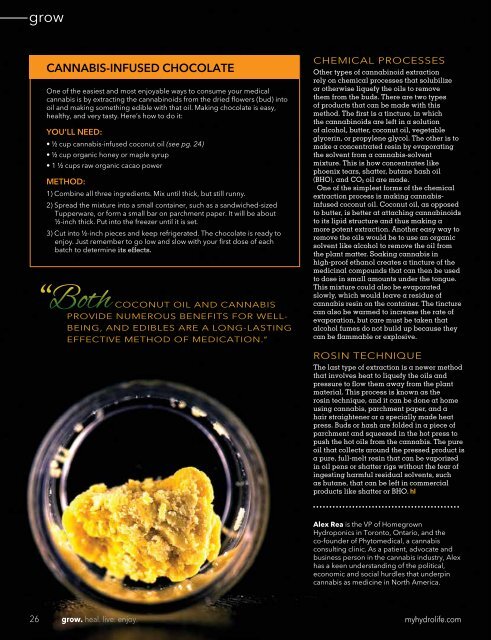Hydrolife Magazine December/January 2017 (USA Edition)
In this issue, we explore Bitcoin and its use in the cannabis industry; how to best insure your growing business; and how dosage is tested. Mark Ward describes how cannabis helped him get back on stage with his band Synthetic Mindset, and Jay Hawley tells us how marijuana inspired him to create Stormebud. With these stories and more, it is clear that the marijuana industry is becoming accepted in virtually every segment of society, and it’s just a matter of time before the federal government legalizes it. It’s an inevitability that even President-elect Trump will have trouble stopping.
In this issue, we explore Bitcoin and its use in the cannabis industry; how to best insure your growing business; and how dosage is tested. Mark Ward describes how cannabis helped him get back on stage with his band Synthetic Mindset, and Jay Hawley tells us how marijuana inspired him to create Stormebud. With these stories and more, it is clear that the marijuana industry is becoming accepted in virtually every segment of society, and it’s just a matter of time before the federal government legalizes it. It’s an inevitability that even President-elect Trump will have trouble stopping.
Create successful ePaper yourself
Turn your PDF publications into a flip-book with our unique Google optimized e-Paper software.
grow<br />
CANNABIS-INFUSED CHOCOLATE<br />
One of the easiest and most enjoyable ways to consume your medical<br />
cannabis is by extracting the cannabinoids from the dried flowers (bud) into<br />
oil and making something edible with that oil. Making chocolate is easy,<br />
healthy, and very tasty. Here’s how to do it:<br />
YOU’LL NEED:<br />
• ½ cup cannabis-infused coconut oil (see pg. 24)<br />
• ½ cup organic honey or maple syrup<br />
• 1 ½ cups raw organic cacao power<br />
METHOD:<br />
1) Combine all three ingredients. Mix until thick, but still runny.<br />
2) Spread the mixture into a small container, such as a sandwiched-sized<br />
Tupperware, or form a small bar on parchment paper. It will be about<br />
½-inch thick. Put into the freezer until it is set.<br />
3) Cut into ½-inch pieces and keep refrigerated. The chocolate is ready to<br />
enjoy. Just remember to go low and slow with your first dose of each<br />
batch to determine its effects.<br />
“Both<br />
COCONUT OIL AND CANNABIS<br />
PROVIDE NUMEROUS BENEFITS FOR WELL-<br />
BEING, AND EDIBLES ARE A LONG-LASTING<br />
EFFECTIVE METHOD OF MEDICATION.”<br />
CHEMICAL PROCESSES<br />
Other types of cannabinoid extraction<br />
rely on chemical processes that solubilize<br />
or otherwise liquefy the oils to remove<br />
them from the buds. There are two types<br />
of products that can be made with this<br />
method. The first is a tincture, in which<br />
the cannabinoids are left in a solution<br />
of alcohol, butter, coconut oil, vegetable<br />
glycerin, or propylene glycol. The other is to<br />
make a concentrated resin by evaporating<br />
the solvent from a cannabis-solvent<br />
mixture. This is how concentrates like<br />
phoenix tears, shatter, butane hash oil<br />
(BHO), and CO 2 oil are made.<br />
One of the simplest forms of the chemical<br />
extraction process is making cannabisinfused<br />
coconut oil. Coconut oil, as opposed<br />
to butter, is better at attaching cannabinoids<br />
to its lipid structure and thus making a<br />
more potent extraction. Another easy way to<br />
remove the oils would be to use an organic<br />
solvent like alcohol to remove the oil from<br />
the plant matter. Soaking cannabis in<br />
high-proof ethanol creates a tincture of the<br />
medicinal compounds that can then be used<br />
to dose in small amounts under the tongue.<br />
This mixture could also be evaporated<br />
slowly, which would leave a residue of<br />
cannabis resin on the container. The tincture<br />
can also be warmed to increase the rate of<br />
evaporation, but care must be taken that<br />
alcohol fumes do not build up because they<br />
can be flammable or explosive.<br />
ROSIN TECHNIQUE<br />
The last type of extraction is a newer method<br />
that involves heat to liquefy the oils and<br />
pressure to flow them away from the plant<br />
material. This process is known as the<br />
rosin technique, and it can be done at home<br />
using cannabis, parchment paper, and a<br />
hair straightener or a specially made heat<br />
press. Buds or hash are folded in a piece of<br />
parchment and squeezed in the hot press to<br />
push the hot oils from the cannabis. The pure<br />
oil that collects around the pressed product is<br />
a pure, full-melt resin that can be vaporized<br />
in oil pens or shatter rigs without the fear of<br />
ingesting harmful residual solvents, such<br />
as butane, that can be left in commercial<br />
products like shatter or BHO.<br />
Alex Rea is the VP of Homegrown<br />
Hydroponics in Toronto, Ontario, and the<br />
co-founder of Phytomedical, a cannabis<br />
consulting clinic. As a patient, advocate and<br />
business person in the cannabis industry, Alex<br />
has a keen understanding of the political,<br />
economic and social hurdles that underpin<br />
cannabis as medicine in North America.<br />
26 grow. heal. live. enjoy.<br />
myhydrolife.com




![Hydrolife Magazine December 2017/January 2018 [CANADIAN EDITION]](https://img.yumpu.com/59790088/1/190x247/hydrolife-magazine-december-2017-january-2018-canadian-edition.jpg?quality=85)
![Hydrolife Magazine December 2017/January 2018 [USA EDITION]](https://img.yumpu.com/59790042/1/190x247/hydrolife-magazine-december-2017-january-2018-usa-edition.jpg?quality=85)
![Hydrolife Magazine October/November 2017 [Canada Edition]](https://img.yumpu.com/59493562/1/190x247/hydrolife-magazine-october-november-2017-canada-edition.jpg?quality=85)
![Hydrolife Magazine October/November 2017 [USA Edition]](https://img.yumpu.com/59493548/1/190x247/hydrolife-magazine-october-november-2017-usa-edition.jpg?quality=85)
![Hydrolife Magazine August/September 2017 [USA Edition]](https://img.yumpu.com/59236656/1/190x247/hydrolife-magazine-august-september-2017-usa-edition.jpg?quality=85)








